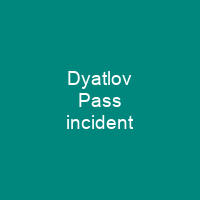Nine Russian hikers died in the northern Ural Mountains between 1 and 2 February 1959, in uncertain circumstances. An investigation by Soviet authorities determined that six had died from hypothermia while the other three had been killed by physical trauma. The investigation concluded that a ‘compelling natural force’ had caused the deaths. Russia opened a new investigation into the incident in 2019, and its conclusions were presented in July 2020.
About Dyatlov Pass incident in brief
 Nine Russian hikers died in the northern Ural Mountains between 1 and 2 February 1959, in uncertain circumstances. The experienced trekking group had established a camp on the slopes of Kholat Syakhl, in an area now named in honour of the group’s leader, Igor Dyatlov. During the night, something caused them to cut their way out of their tents and flee the campsite while inadequately dressed for the heavy snowfall and subzero temperatures. An investigation by Soviet authorities determined that six had died from hypothermia while the other three had been killed by physical trauma. Four of the bodies were found lying in running water in a creek, and three of these had soft tissue damage of the head and face. The investigation concluded that a ‘compelling natural force’ had caused the deaths. Russia opened a new investigation into the incident in 2019, and its conclusions were presented in July 2020: that an avalanche had led to the deaths, and that survivors of the avalanche had been forced to suddenly leave their camp in low visibility conditions with inadequate clothing, and had died ofhypothermia. According to Prosecutor Tempalov, documents that were found in the tent of the expedition suggest that the expedition was named for the 21st Congress of the Communist Party of the Soviet Union, and was possibly dispatched by the local Komsomol organisation. The group left the Sverdlovsk city on the same day they received the route book.
Nine Russian hikers died in the northern Ural Mountains between 1 and 2 February 1959, in uncertain circumstances. The experienced trekking group had established a camp on the slopes of Kholat Syakhl, in an area now named in honour of the group’s leader, Igor Dyatlov. During the night, something caused them to cut their way out of their tents and flee the campsite while inadequately dressed for the heavy snowfall and subzero temperatures. An investigation by Soviet authorities determined that six had died from hypothermia while the other three had been killed by physical trauma. Four of the bodies were found lying in running water in a creek, and three of these had soft tissue damage of the head and face. The investigation concluded that a ‘compelling natural force’ had caused the deaths. Russia opened a new investigation into the incident in 2019, and its conclusions were presented in July 2020: that an avalanche had led to the deaths, and that survivors of the avalanche had been forced to suddenly leave their camp in low visibility conditions with inadequate clothing, and had died ofhypothermia. According to Prosecutor Tempalov, documents that were found in the tent of the expedition suggest that the expedition was named for the 21st Congress of the Communist Party of the Soviet Union, and was possibly dispatched by the local Komsomol organisation. The group left the Sverdlovsk city on the same day they received the route book.
On January 28, one member, Yuri Yudin, who suffered from several health ailments, turned back due to knee and joint pain that made him unable to continue the hike. The remaining nine hikers continued the trek toward Gora Otorten, and on January 31, a group of Diaries and cameras found around the edge of the last campsite. This is the last inhabited lorry village to the north of Vizhai. While spending the night in Vizhai, skiers purchased bread and ate loaves of bread to keep their energy levels up for the following day’s hike. At the time, this was the highest certification available in the SovietUnion, and required candidates to traverse 300 kilometres. The route was designed by Dyatlovsky’s group to reach the far northern regions of Sverdamn, and the upper-streams of the Lozva river. The goal of the trip was to reach Gora otorten, a mountain 10 kilometres north of the site where the incident occurred. On 23 January 1959 the Dyatlovo group was issued their route book which listed their course as following the No. 5 trail. The 11th person was listed as Semyon Zolotaryov who was previously certified to go with another expedition of similar difficulty. They then took a truck to Vizhai, a village that is in the last lorry settlement to the North. On the day of the trek, they began their trek to Goraotorten. The last day of January 27, the group arrived at the end of the route.
You want to know more about Dyatlov Pass incident?
This page is based on the article Dyatlov Pass incident published in Wikipedia (as of Jan. 04, 2021) and was automatically summarized using artificial intelligence.







